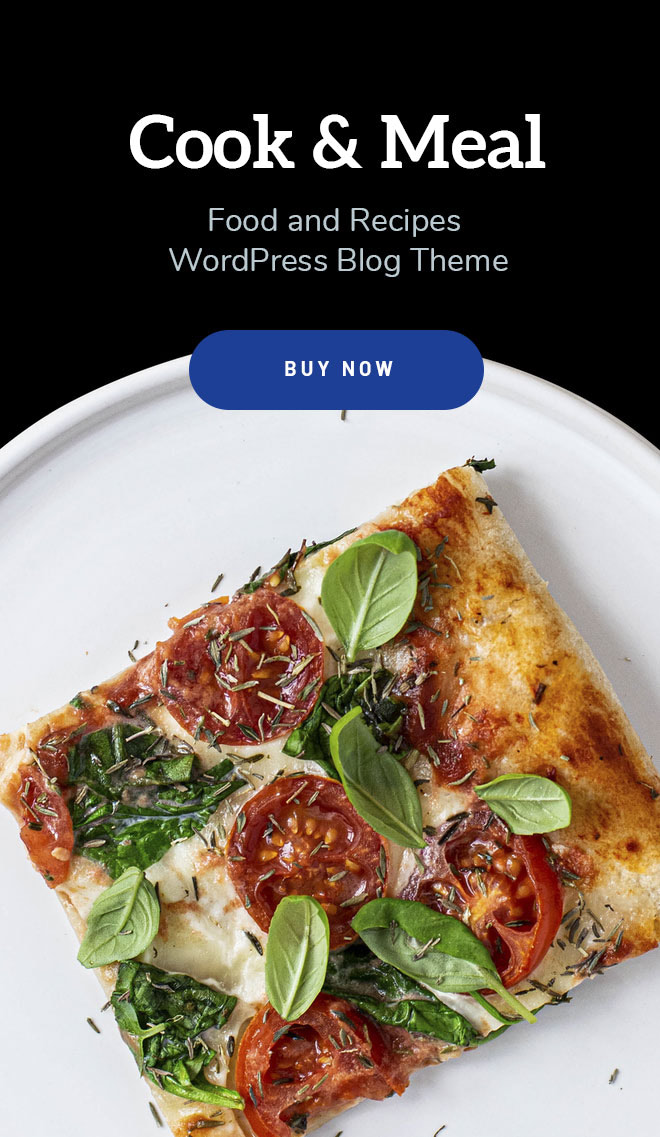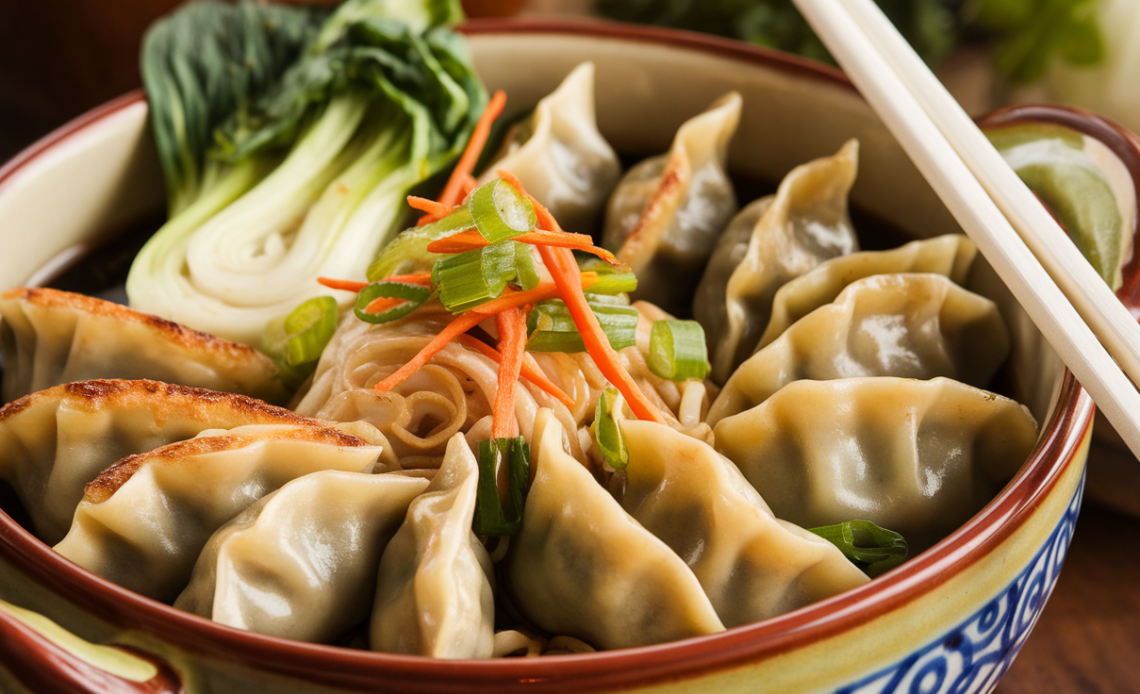
When it comes to comforting and flavorful meals that satisfy both the palate and the soul, Potsticker Noodle Bowls rank high among the favorites in Asian cooking. Combining crispy pan-fried potstickers, hearty noodles or vegetable alternatives, fresh crunchy vegetables, and savory umami-packed sauces, this dish offers a delightful blend of textures and flavors.
Whether you’re a fan of classic noodle dishes, curious about incorporating dishes like Mapo Tofu, or looking for versatile Whole 30 recipes, this potsticker bowl will quickly become your go-to meal for busy weeknights or casual gatherings.
In this detailed guide, we’ll explore every aspect of creating the perfect Potsticker Noodle Bowls, including ingredient options, cooking methods, health benefits, and delicious twists — all while highlighting the best ways to make this a balanced, exciting bowls recipe.
The Allure of Noodle Bowls Recipes in Asian Cuisine
Noodle bowls recipes have become a global culinary sensation because they are so versatile and convenient. Rooted in various Asian cuisines like Chinese, Japanese, Korean, and Thai, these bowls mix carbohydrates, proteins, fats, and vegetables into one satisfying dish that can be tailored to almost any dietary preference.
Potstickers are a perfect companion to these bowls, adding that crispy, savory bite alongside tender noodles and vibrant vegetables. The contrast of textures — chewy dumpling wrappers, crunchy veggies, silky noodles — creates a sensory experience that is both comforting and exciting.
What Are Potstickers? A Quick Overview
Potstickers, known as jiaozi in Mandarin or gyoza in Japanese, are pan-fried dumplings filled with a variety of savory ingredients like ground pork, shrimp, or vegetables. What sets potstickers apart from steamed or boiled dumplings is their cooking technique: they are first fried in a hot pan to crisp up the bottoms and then steamed with a little water to finish cooking, resulting in a delightful crispy-chewy texture.
Why This Recipe Works for So Many: From Classic to Whole 30
Thanks to the flexibility in ingredients, potsticker noodle bowls can be adapted to many dietary preferences:
- Classic Asian Dishes lovers can enjoy the traditional pork or chicken potstickers served with egg noodles and rich soy-based sauces.
- Fans of Whole 30 recipes or low-carb meals can swap noodles with roasted spaghetti squash, use compliant sauces (tamari instead of soy sauce), and choose vegetable or chicken potstickers with no sugar or preservatives.
- Vegetarians or vegans can select tofu or vegetable potstickers, add a spicy Mapo Tofu sauce (modified to be vegan), and add a poached egg substitute or omit it entirely.
This recipe makes it easy to cater to your personal taste while enjoying the authenticity and flavors of Asian cooking.
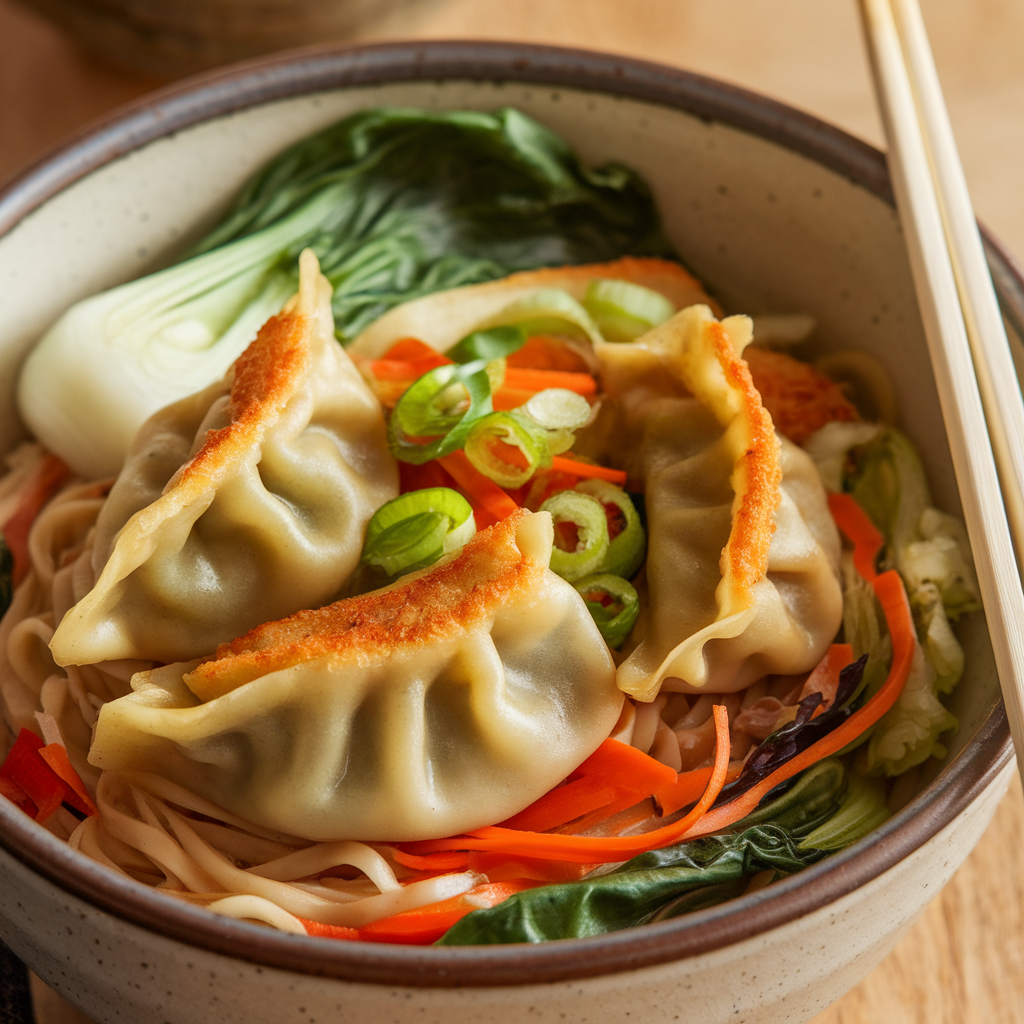
Essential Ingredients: Building Your Potsticker Noodle Bowl
1. Potstickers: The Star of the Bowl
- Homemade or store-bought: Making your own potstickers allows you to control ingredients, but good quality store-bought potstickers can save time.
- Popular fillings include ground pork with cabbage, chicken and ginger, shrimp and scallions, or a vegetarian mix with mushrooms and tofu.
2. Noodles or Alternatives
- Classic choices: Egg noodles, wheat noodles, or rice noodles.
- Low-carb substitutes: Roasted spaghetti squash or zucchini noodles.
- Noodle texture impacts the bowl’s mouthfeel—egg noodles add chewiness, while spaghetti squash brings a light, fresh bite.
3. Vegetables
- Leafy greens like bok choy or napa cabbage.
- Crunchy additions such as shredded carrots, snap peas, bean sprouts, or bell peppers.
- Mushrooms (shiitake or cremini) add earthiness and umami.
4. Egg
- Soft-boiled eggs with runny yolks add creaminess and protein.
- For a vegan option, try silken tofu or avocado slices.
5. Sauce and Aromatics
- Soy sauce or tamari (for gluten-free).
- Sesame oil for nutty aroma.
- Fresh garlic and ginger for pungency.
- Chili paste or fresh chilies for heat.
- Rice vinegar or lime juice to brighten.
- Optional: Mapo Tofu sauce or a homemade spicy bean paste sauce for extra kick.
Detailed Step-by-Step Preparation Guide
Step 1: Cooking the Potstickers Perfectly
- Use a non-stick skillet with a tablespoon of neutral oil (canola or vegetable).
- Place potstickers flat-side down without overcrowding. Fry until the bottoms are golden brown (about 2-3 minutes).
- Add about ¼ cup of water, cover tightly with a lid, and steam for 5-7 minutes until the water evaporates and potstickers are cooked through.
- Remove the lid and let the potstickers crisp up again for 1-2 minutes for maximum texture.
Pro tip: Use a lid that seals well to trap steam, which helps cook the filling thoroughly while keeping the bottoms crispy.
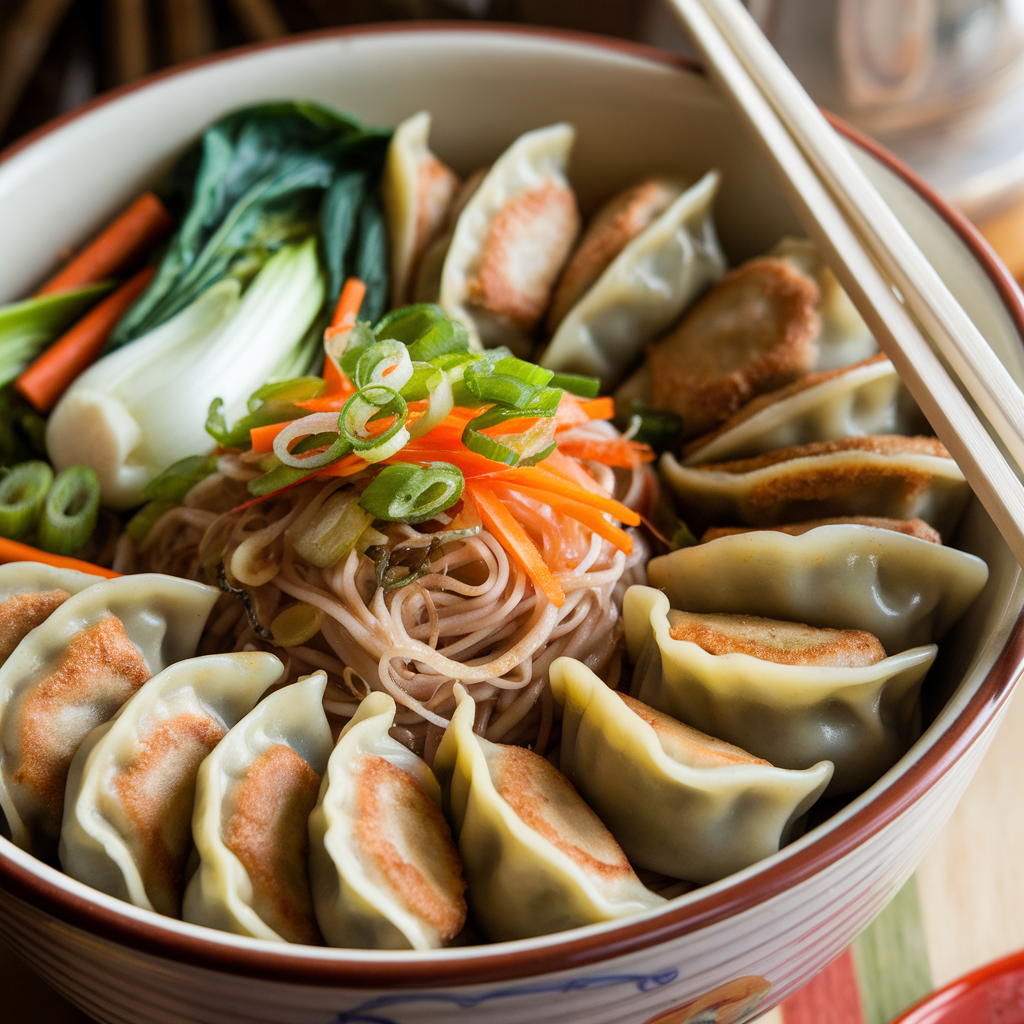
Step 2: Preparing the Noodles or Spaghetti Squash
- Traditional noodles: Boil in salted water according to package directions, then drain and rinse with cold water to stop cooking.
- Spaghetti squash:
- Cut the squash in half lengthwise, scoop out seeds.
- Drizzle with olive oil and season with salt and pepper.
- Roast face-down on a baking sheet at 400°F (200°C) for 40 minutes or until tender.
- Scrape the flesh into strands with a fork to mimic noodles.
Step 3: Cooking and Preparing Vegetables
- Lightly steam or sauté bok choy, snap peas, mushrooms, and carrots. Aim for crisp-tender texture to preserve nutrients and color.
- Quick sauté with a splash of sesame oil and garlic enhances flavor.
Step 4: Soft-Boiling the Egg
- Bring a pot of water to boil.
- Carefully lower eggs into boiling water and cook for 6-7 minutes for soft yolk.
- Transfer to ice water bath to stop cooking and make peeling easier.
- Slice in half just before serving.
Step 5: Crafting the Sauce
- Whisk together:
- 3 tablespoons soy sauce or tamari
- 1 tablespoon sesame oil
- 1 teaspoon grated fresh ginger
- 1 clove minced garlic
- 1 teaspoon rice vinegar or lime juice
- Chili paste or sriracha to taste
- For a spicier, richer flavor, add 1 tablespoon of Mapo Tofu sauce or a homemade spicy bean paste.
Step 6: Assemble the Bowl
- Start with a bed of noodles or spaghetti squash.
- Arrange potstickers and vegetables artfully on top.
- Drizzle with sauce generously.
- Add a soft-boiled egg half.
- Garnish with sliced scallions, toasted sesame seeds, and fresh cilantro or basil.
How to Incorporate Mapo Tofu Into Your Bowl
Mapo Tofu is a famous Sichuan dish known for its spicy, numbing flavor thanks to chili oil and Sichuan peppercorns. While traditional Mapo Tofu is made with soft tofu and ground pork, you can adapt the sauce as a flavorful condiment or a stir-in for your noodle bowl.
Quick Mapo Tofu Sauce:
- Stir-fry minced garlic and ginger.
- Add fermented black bean paste, chili bean paste (doubanjiang), soy sauce, and a pinch of sugar.
- Add diced soft tofu and simmer gently.
- Pour over your potsticker noodle bowl or serve on the side for dipping.
This addition transforms your bowl from simple to complex, adding bold heat and richness.
Health Benefits of Potsticker Noodle Bowls
- Balanced Nutrition: Potstickers provide protein, noodles or spaghetti squash supply complex carbs or fiber, and vegetables add vitamins, minerals, and antioxidants.
- Egg Protein: The soft-boiled egg contributes high-quality protein and essential nutrients like choline and B vitamins.
- Gluten-Free Options: Using tamari and spaghetti squash accommodates gluten sensitivities and Whole 30 diets.
- Vegetable-Rich: Steamed and fresh vegetables boost fiber and support digestion.
- Low in Processed Ingredients: When made at home or with mindful ingredient choices, the bowl can be free of additives, excess sodium, and preservatives.
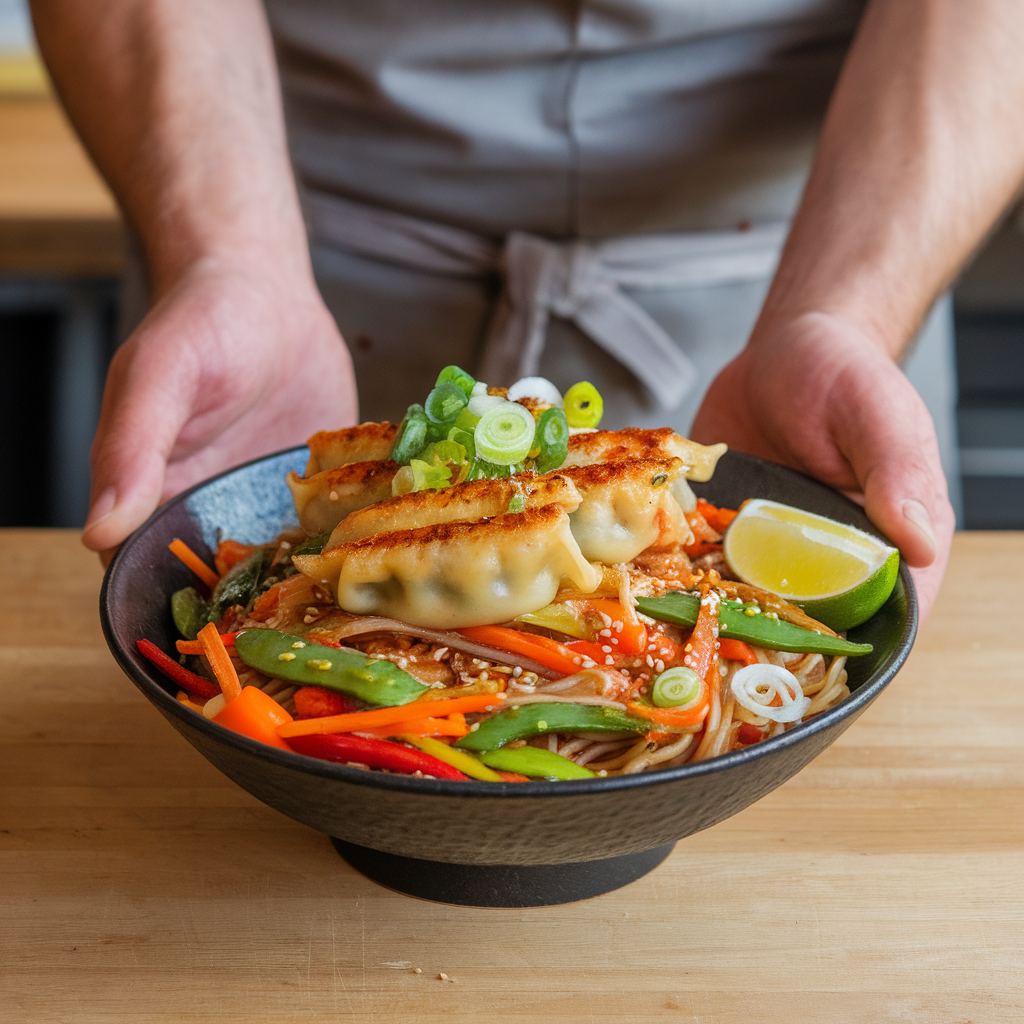
Variations and Creative Twists on Potsticker Noodle Bowls
1. Vegan or Vegetarian
- Use vegetable or tofu-filled potstickers.
- Skip eggs or use tofu scramble as a substitute.
- Add extra mushrooms and greens for umami and texture.
2. Low-Carb and Whole 30
- Replace noodles with spaghetti squash or zucchini noodles.
- Use compliant sauces (tamari, no sugar).
- Choose homemade or Whole 30-approved potstickers.
3. Protein-Packed Bowls
- Add grilled chicken, shrimp, or extra tofu cubes.
- Top with a poached egg for richness.
4. Spicy Lover’s Bowl
- Add extra chili paste or fresh sliced chilies.
- Drizzle chili oil for heat and flavor.
Storing and Meal Prep Tips
- Prepare each component separately and store in airtight containers.
- Potstickers can be frozen before or after cooking — just reheat in a skillet for crispiness.
- Noodles and veggies can be reheated quickly in the microwave or sauté pan.
- Sauce should be stored separately to avoid sogginess.
- Soft-boiled eggs are best made fresh but can be prepped a day ahead and refrigerated.
Frequently Asked Questions
Q: Can I use frozen potstickers?
A: Yes, frozen potstickers work well. Cook from frozen, just add a couple of minutes to steaming time.
Q: What if I can’t find Mapo Tofu sauce?
A: You can make a simple version with chili bean paste, garlic, ginger, soy sauce, and a little sugar, or use chili garlic sauce for a shortcut.
Q: How can I make the egg easier to peel?
A: Use slightly older eggs and immediately cool them in ice water after boiling.
Q: Are potstickers healthy?
A: When made with lean protein and plenty of vegetables, potstickers can be a nutritious part of a balanced meal.
Final Thoughts: Why Potsticker Noodle Bowls Should Be in Your Recipe Collection
The joy of a Potsticker Noodle Bowl lies in its perfect harmony of flavor, texture, and nutrition. It captures the essence of Asian dishes with its savory potstickers, vibrant vegetables, and umami-rich sauces, while offering the versatility to fit different lifestyles — from indulgent to clean eating with Whole 30 recipes.
Adding an egg brings richness, and the option to incorporate Mapo Tofu introduces a spicy depth that is hard to resist. Plus, swapping noodles for spaghetti squash makes this dish accessible to those on low-carb or gluten-free diets without sacrificing flavor.
This bowl isn’t just food; it’s an experience — a celebration of textures, aromas, and colors that make every meal exciting. Try this recipe, share it with friends, and enjoy a delicious journey through one of the best noodle bowls recipes out there.




